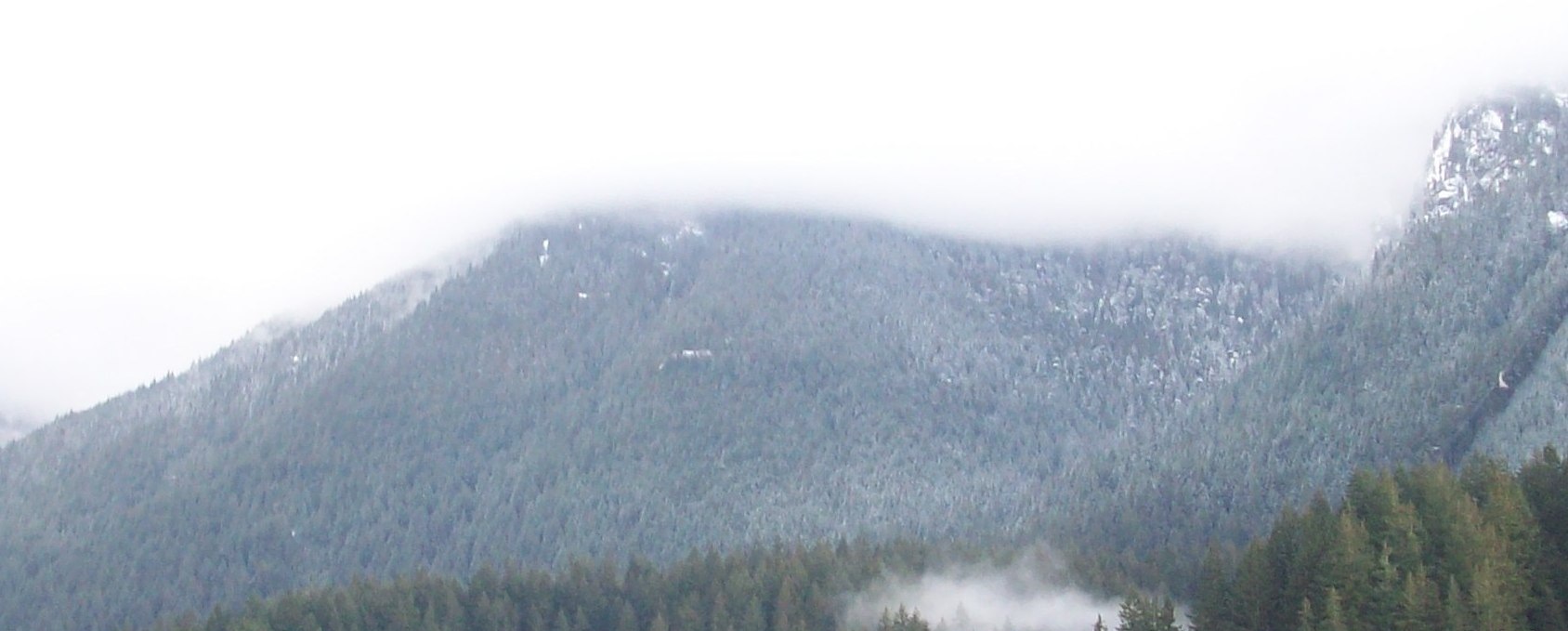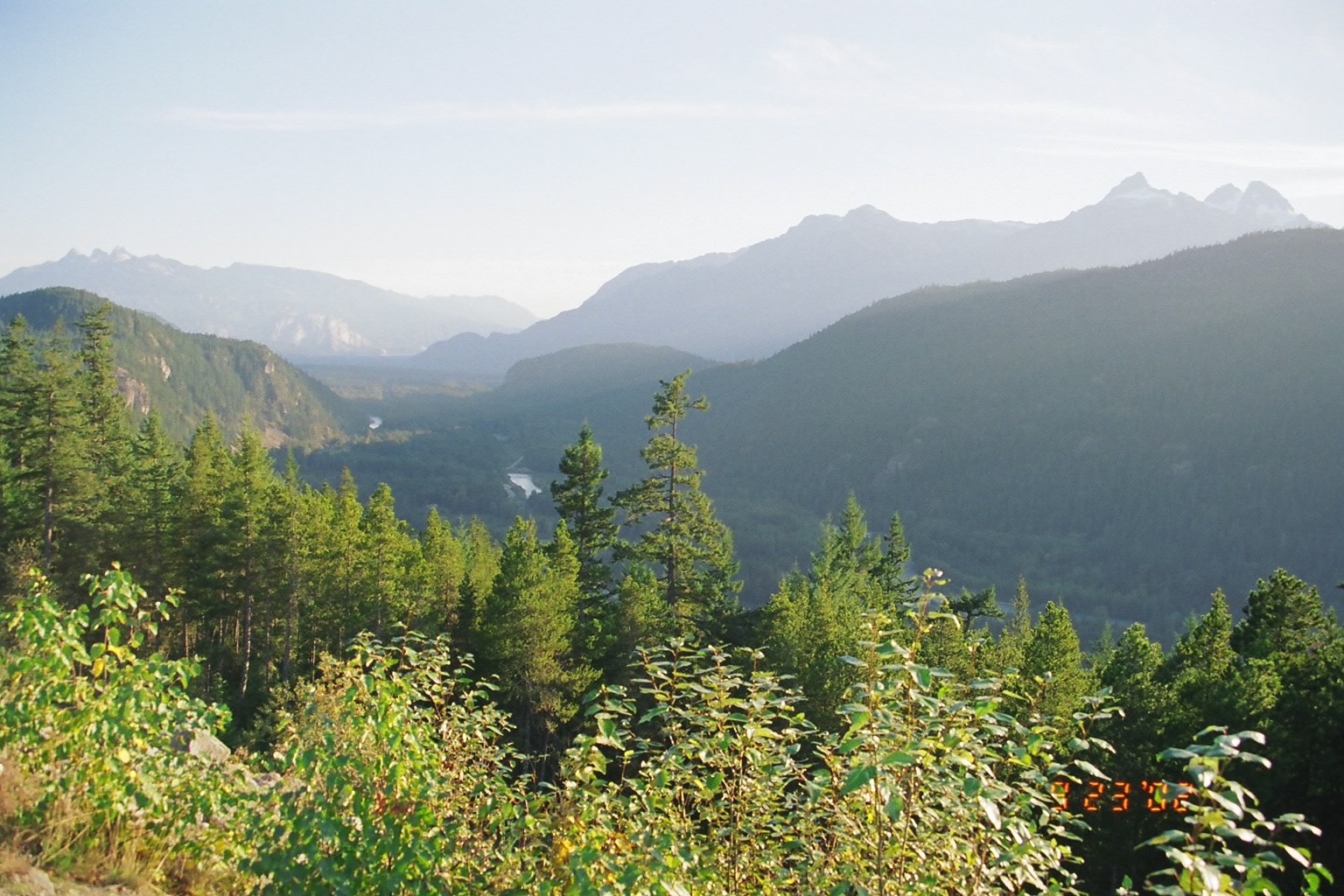|
Sisqa Peak
Sisqa Peak is a mountain in British Columbia, Canada. Description Sisqa Peak is located west of Pemberton, in the Pemberton Icefield of the Coast Mountains. Precipitation runoff and glacial meltwater from this mountain drains into the Soo River and Rutherford Creek, which are both tributaries of the Green River, which in turn is a tributary of the Lillooet River. Topographic relief is significant with the summit rising 1,400 metres (4,593 ft) above the Soo Valley in approximately . The mountain's toponym was officially adopted on 15 January 1987 by the Geographical Names Board of Canada. "Sisqa" is the Lil'wat word for "uncle." Climate Based on the Köppen climate classification, Sisqa Peak is located in the marine west coast climate zone of western North America. Most weather fronts originating in the Pacific Ocean travel east toward the Coast Mountains where they are forced upward by the range (orographic lift), causing them to drop their moisture in the form of ... [...More Info...] [...Related Items...] OR: [Wikipedia] [Google] [Baidu] |
Coast Mountains
The Coast Mountains () are a major mountain range in the Pacific Coast Ranges of western North America, extending from southwestern Yukon through the Alaska Panhandle and virtually all of the British Columbia Coast, Coast of British Columbia south to the Fraser River. The mountain range's name derives from its proximity to the sea coast, and it is often referred to as the Coast Range. The range includes volcanic and non-volcanic mountains and the extensive ice fields of the Pacific Ranges, Pacific and Boundary Ranges, and the northern end of the volcano, volcanic system known as the Cascade Volcanoes. The Coast Mountains are part of a larger mountain system called the Pacific Coast Ranges or the Pacific Mountain System, which includes the Cascade Range, the Insular Mountains, the Olympic Mountains, the Oregon Coast Range, the California Coast Ranges, the Saint Elias Mountains and the Chugach Mountains. The Coast Mountains are also part of the American Cordilleraa Spanish term for ... [...More Info...] [...Related Items...] OR: [Wikipedia] [Google] [Baidu] |
Geographical Names Board Of Canada
The Geographical Names Board of Canada (GNBC) is a national committee with a secretariat in Natural Resources Canada, part of the Government of Canada, which authorizes the names used and name changes on official federal government maps of Canada. History It was created in December 1897, by Order in Council, as the Geographic Board of Canada. It consisted of one Board member from each of four Government of Canada departments, as well as the Surveyor General of Dominion Lands, while a secretariat was provided by the then-extant Department of the Interior. In December 1899, the Order in Council was amended to give the Canadian provinces and territories the right to nominate one official, each, to be a Board member. The board was succeeded by the Canadian Board on Geographic Names in 1948, then reorganized as the Canadian Permanent Committee on Geographic Names (CPCGN) in 1961. Structure , the Board consists of 27 members, one from each of the provinces and territories, and ot ... [...More Info...] [...Related Items...] OR: [Wikipedia] [Google] [Baidu] |
Ipsoot Mountain
Ipsoot Mountain is a glaciated summit located in southwest British Columbia, Canada. Description Ipsoot Mountain is situated in the Coast Mountains, west of Pemberton and north of Whistler. Precipitation runoff and glacial meltwater from this large mountain drains into Pemberton, Miller and Rutherford creeks, then eventually Lillooet River. Ipsoot is more notable for its steep rise above local terrain than for its absolute elevation as topographic relief is significant with the summit rising over 1,800 meters (5,900 ft) above Rutherford Creek in approximately . The mountain was named by the first ascent party, and "ipsoot" means "hidden", or "to hide" in Chinook Jargon, as this peak is indeed hidden from view in adjacent valleys. The toponym was officially adopted June 22, 1967, by the Geographical Names Board of Canada. Climate Based on the Köppen climate classification, Ipsoot Mountain is located in the marine west coast climate zone of western North America. M ... [...More Info...] [...Related Items...] OR: [Wikipedia] [Google] [Baidu] |
Rhododendron Mountain
Rhododendron Mountain is a glaciated summit in British Columbia, Canada. Description Rhododendron Mountain is located in the Coast Mountains, west-northwest of Pemberton and north of Ipsoot Mountain. Precipitation runoff and glacial meltwater from this mountain drains into Ryan River, Miller Creek and Rutherford Creek, which all flow to the Lillooet River. Rhododendron Mountain is more notable for its steep rise above local terrain than for its absolute elevation as topographic relief is significant with the summit rising over 1,300 metres (4,265 ft) above Rutherford Creek in approximately . The mountain's local toponym was officially adopted January 23, 1979, by the Geographical Names Board of Canada. Climate Based on the Köppen climate classification, Rhododendron Mountain is located in the marine west coast climate zone of western North America. Most weather fronts originate in the Pacific Ocean, and travel east toward the Coast Mountains where they are forced ... [...More Info...] [...Related Items...] OR: [Wikipedia] [Google] [Baidu] |
Geography Of British Columbia
British Columbia is the westernmost province of Canada, bordered by the Pacific Ocean. With an area of it is Canada's third-largest province. The province is almost four times the size of the United Kingdom and larger than every United States state except Alaska. It is bounded on the northwest by the U.S. state of Alaska, directly north by Yukon and the Northwest Territories, on the east by Alberta, and on the south by the U.S. states of Washington, Idaho, and Montana. Formerly part of the British Empire, the southern border of British Columbia was established by the 1846 Oregon Treaty. The province is dominated by mountain ranges, among them the Canadian Rockies but dominantly the Coast Mountains, Cassiar Mountains, and the Columbia Mountains. Most of the population is concentrated on the Pacific coast, notably in the area of Vancouver, located on the southwestern tip of the mainland, which is known as the Lower Mainland. It is the most mountainous province of Canada. St ... [...More Info...] [...Related Items...] OR: [Wikipedia] [Google] [Baidu] |
Orographic Lift
Orographic lift occurs when an air mass is forced from a low elevation to a higher elevation as it moves over rising terrain. As the air mass gains altitude it quickly cools down adiabatically, which can raise the relative humidity to 100% and create clouds and, under the right conditions, precipitation. Orographic lifting can have a number of effects, including precipitation, rain shadowing, leeward winds, and associated clouds. Precipitation Precipitation induced by orographic lift occurs in many places throughout the world. Examples include: * The Mogollon Rim in central Arizona * The western slope of the Sierra Nevada range in California. * The western slope of the Wasatch Range in Utah. Specifically the Little and Big Cottonwood Canyons. * The mountains near Baja California North – specifically La Bocana to Laguna Hanson. * The windward slopes of Khasi and Jayantia Hills (see Mawsynram) in the state of Meghalaya in India. * The Western Highlands of Yemen, which rece ... [...More Info...] [...Related Items...] OR: [Wikipedia] [Google] [Baidu] |
Weather Front
A weather front is a boundary separating air masses for which several characteristics differ, such as air density, wind, temperature, and humidity. Disturbed and unstable weather due to these differences often arises along the boundary. For instance, cold fronts can bring bands of thunderstorms and cumulonimbus precipitation or be preceded by squall lines, while warm fronts are usually preceded by stratiform precipitation and fog. In summer, subtler humidity gradients known as dry lines can trigger severe weather. Some fronts produce no precipitation and little cloudiness, although there is invariably a wind shift. Cold fronts generally move from west to east, whereas warm fronts move poleward, although any direction is possible. Occluded fronts are a hybrid merge of the two, and stationary fronts are stalled in their motion. Cold fronts and cold occlusions move faster than warm fronts and warm occlusions because the dense air behind them can lift as well as push the warme ... [...More Info...] [...Related Items...] OR: [Wikipedia] [Google] [Baidu] |
Marine West Coast
An oceanic climate, also known as a marine climate or maritime climate, is the temperate climate sub-type in Köppen classification represented as ''Cfb'', typical of west coasts in higher middle latitudes of continents, generally featuring cool to warm summers and cool to mild winters (for their latitude), with a relatively narrow annual temperature range and few extremes of temperature. Oceanic climates can be found in both hemispheres generally between 40 and 60 degrees latitude, with subpolar versions extending to 70 degrees latitude in some coastal areas. Other varieties of climates usually classified together with these include subtropical highland climates, represented as ''Cwb'' or ''Cfb'', and subpolar oceanic or cold subtropical highland climates, represented as ''Cfc'' or ''Cwc''. Subtropical highland climates occur in some mountainous parts of the subtropics or tropics, some of which have monsoon influence, while their cold variants and subpolar oceanic climates occu ... [...More Info...] [...Related Items...] OR: [Wikipedia] [Google] [Baidu] |
Köppen Climate Classification
The Köppen climate classification divides Earth climates into five main climate groups, with each group being divided based on patterns of seasonal precipitation and temperature. The five main groups are ''A'' (tropical), ''B'' (arid), ''C'' (temperate), ''D'' (continental), and ''E'' (polar). Each group and subgroup is represented by a letter. All climates are assigned a main group (the first letter). All climates except for those in the ''E'' group are assigned a seasonal precipitation subgroup (the second letter). For example, ''Af'' indicates a tropical rainforest climate. The system assigns a temperature subgroup for all groups other than those in the ''A'' group, indicated by the third letter for climates in ''B'', ''C'', ''D'', and the second letter for climates in ''E''. Other examples include: ''Cfb'' indicating an oceanic climate with warm summers as indicated by the ending ''b.'', while ''Dwb'' indicates a semi-Monsoon continental climate, monsoonal continental climate ... [...More Info...] [...Related Items...] OR: [Wikipedia] [Google] [Baidu] |
Topographic Relief
Terrain (), alternatively relief or topographical relief, is the dimension and shape of a given surface of land. In physical geography, terrain is the lay of the land. This is usually expressed in terms of the elevation, slope, and orientation of terrain features. Terrain affects surface water flow and distribution. Over a large area, it can affect weather and climate patterns. Bathymetry is the study of underwater relief, while hypsometry studies terrain relative to sea level. Importance The understanding of terrain is critical for many reasons: * The terrain of a region largely determines its suitability for human settlement: flatter alluvial plains tend to have better farming soils than steeper, rockier uplands. * In terms of environmental quality, agriculture, hydrology and other interdisciplinary sciences; understanding the terrain of an area assists the understanding of watershed boundaries, drainage characteristics, drainage systems, groundwater systems, water ... [...More Info...] [...Related Items...] OR: [Wikipedia] [Google] [Baidu] |
Canada
Canada is a country in North America. Its Provinces and territories of Canada, ten provinces and three territories extend from the Atlantic Ocean to the Pacific Ocean and northward into the Arctic Ocean, making it the world's List of countries and dependencies by area, second-largest country by total area, with the List of countries by length of coastline, world's longest coastline. Its Canada–United States border, border with the United States is the world's longest international land border. The country is characterized by a wide range of both Temperature in Canada, meteorologic and Geography of Canada, geological regions. With Population of Canada, a population of over 41million people, it has widely varying population densities, with the majority residing in List of the largest population centres in Canada, urban areas and large areas of the country being sparsely populated. Canada's capital is Ottawa and List of census metropolitan areas and agglomerations in Canada, ... [...More Info...] [...Related Items...] OR: [Wikipedia] [Google] [Baidu] |







